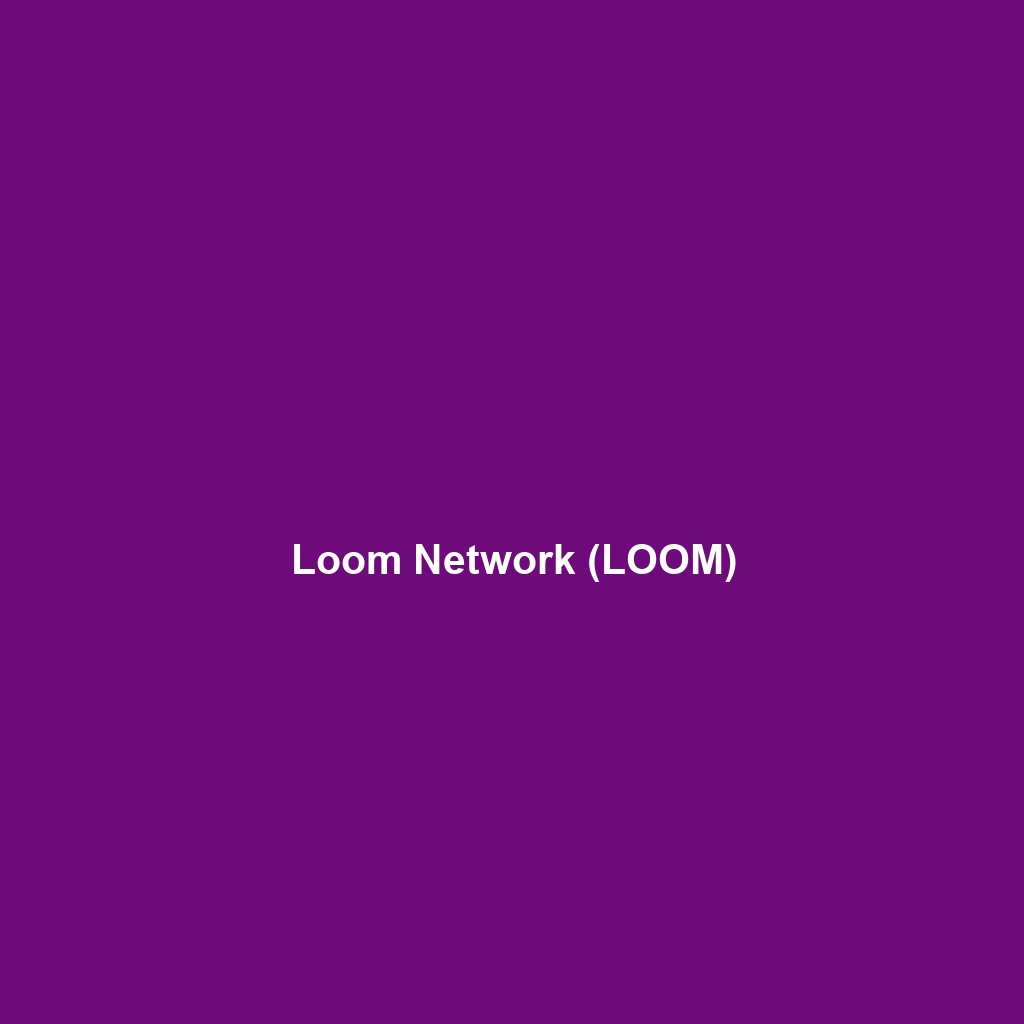Your cart is currently empty!
Tag: community engagement

Loom Network (LOOM)
Loom Network (LOOM): A Comprehensive Overview
Loom Network (LOOM) is a cryptocurrency that stands out in the rapidly expanding world of blockchain technology. This detailed description covers the essential aspects that make LOOM a noteworthy digital asset, along with its historical significance, technical attributes, and future potential in the cryptocurrency ecosystem.
1. Name and Ticker Symbol
The official name of the cryptocurrency is Loom Network, and its ticker symbol is LOOM.
2. Founders, Launch Date, and History
Loom Network was co-founded by Matthew Campbell, Rami Tärn, and Diego Oppenheimer, who aimed to address the scalability issues facing dApps (decentralized applications) on the Ethereum blockchain. The project launched in 2018 and has seen several key milestones, such as the introduction of the Loom SDK and the deployment of the Loom Network mainnet. The project has evolved significantly, with various partnerships and protocol upgrades enhancing its functionality.
3. Blockchain Platform
Loom Network operates on the Ethereum blockchain, making it a layer 2 scaling solution designed to reduce congestion and enhance the user experience of dApps. This platform allows developers to create high-throughput applications without compromising security.
4. Purpose and Use Case
The primary purpose of Loom Network is to facilitate the development of dApps with a focus on gaming. It provides a seamless environment for building blockchain games, social applications, and other decentralized solutions that require high scalability. Notable use cases include in-game asset ownership and integration of non-fungible tokens (NFTs).
5. Technology and Consensus Mechanism
Loom Network employs a technology framework known as Plasma, which allows for fast and secure off-chain transactions. It utilizes a modified version of the Delegated Proof of Stake (DPoS) consensus mechanism, enabling a more efficient means of transaction validation while maintaining decentralization.
6. Supply and Tokenomics
The total maximum supply of LOOM tokens is 1 billion, with a circulating supply that fluctuates due to various staking and burning mechanisms. Users can earn staking rewards by participating in the network and contributing to its security, while burn mechanisms help control the token supply and enhance value.
7. Use Cases and Adoption
Loom Network has found real-world applications in the gaming industry, attracting attention from developers creating blockchain-based games. Partnerships with platforms like CryptoKitties and gaming dApps on its ecosystem demonstrate its adoption in the DeFi sector.
8. Market Performance and Metrics
As of now, Loom Network boasts a market capitalization of approximately $100 million. Historical price trends indicate volatility, with LOOM experiencing significant swings in value. The trading volume remains consistent, reflecting active trading amongst investors.
9. Where to Buy and Trade
LOOM tokens can be traded on various cryptocurrency exchanges, including both centralized exchanges (CEXs) like Binance and decentralized exchanges (DEXs) such as Uniswap. These platforms offer users flexibility in buying and trading LOOM.
10. Security and Risks
Like all cryptocurrencies, Loom Network faces security vulnerabilities. While there have been no major hacks reported against LOOM, users should remain cautious and protect their assets through best security practices. Legal and regulatory risks are also present in the ever-evolving crypto landscape.
11. Community and Governance
Loom Network operates a community-driven governance model, allowing token holders to participate in decision-making processes. Community engagement is facilitated through platforms like Discord and Telegram, creating an active dialogue for project development.
12. Competitors and Differentiation
LOOM differentiates itself from competitors like Polygon and Chainlink by focusing specifically on gaming and social applications. Its unique framework allows developers to create user-friendly applications without the traditional complexities associated with blockchain development.
13. Roadmap and Future Developments
The future of Loom Network looks promising, with ongoing developments aimed at enhancing functionality and interoperability. Upcoming partnerships and protocol upgrades are expected to elevate the network’s capabilities and broaden its scope in various applications.
14. Wallet Compatibility
LOOM tokens are compatible with several popular wallets, including MetaMask and Ledger. These wallets enable secure storage and easy management of LOOM assets for users.
15. Regulatory and Compliance Status
Loom Network operates within a framework of evolving regulations. While the project has not faced significant legal challenges, ongoing changes in regulatory policies across jurisdictions may impact its operations and compliance measures.
16. Recent News and Updates
Recent updates to Loom Network include partnerships with new gaming platforms, technology upgrades aimed at improving user experience, and expansion efforts to attract more developers to its ecosystem. These developments reflect the project’s commitment to growth and innovation.
17. Summary and Call to Action
Loom Network (LOOM) presents a compelling opportunity for cryptocurrency enthusiasts and developers alike, particularly in the gaming sector. With its solid technological foundation, active community, and promising future initiatives, LOOM is a digital asset worth following. For more insights into the cryptocurrency landscape, consider tracking LOOM’s progress and exploring its potential.
For additional insights, visit UpCube.net. Also, check out the cryptocurrency’s official website for more information.

Linear Finance (LINA)
Linear Finance (LINA): Comprehensive Overview
Linear Finance (LINA) is an innovative cryptocurrency that has made significant strides in the decentralized finance (DeFi) space. Launched in 2020, LINA aims to provide continuous liquidity and enable seamless trading of synthetic assets. This article delves deep into the unique attributes of Linear Finance, including its founders, purpose, technology, market performance, and future outlook.
1. Name and Ticker Symbol
The cryptocurrency is known as Linear Finance and is represented by the ticker symbol LINA.
2. Founders, Launch Date, and History
Linear Finance was founded by a team of seasoned professionals in the blockchain industry, including key figures like Kevin Tai and Matthew H. Wong. The project was officially launched in 2020. Since its inception, Linear Finance has hit various milestones, including its significant initial coin offering (ICO) and partnerships with leading platforms, further highlighting its commitment to providing accessibility and usability in the crypto space.
3. Blockchain Platform
Linear Finance operates on the Ethereum blockchain. This allows the platform to leverage Ethereum’s robust technology while enabling developers to build decentralized applications (dApps). Linear Finance is primarily classified as a Layer 2 solution, which helps in scaling transactions and providing lower fees for users.
4. Purpose and Use Case
The primary purpose of Linear Finance is to create a platform where users can mint, trade, and manage synthetic assets in a decentralized manner. These synthetic assets can represent real-world assets like stocks, currencies, and commodities. Use cases include investment diversification, speculation, and providing liquidity for decentralized exchanges (DEXs).
5. Technology and Consensus Mechanism
Linear Finance utilizes cutting-edge blockchain technology and operates on a Proof of Stake (PoS) consensus mechanism. This approach not only enhances network security but also improves transaction speed and efficiency. By minimizing energy consumption compared to traditional Proof of Work systems, Linear Finance adopts a more sustainable method for validating transactions.
6. Supply and Tokenomics
The total supply of LINA is capped at 10 billion tokens, with a current circulating supply estimated at approximately 3 billion tokens. A portion of the tokens is allocated for staking rewards, incentivizing users to contribute to the network’s liquidity and stability. Linear Finance also implements a burn mechanism to decrease supply over time, potentially increasing the token’s value.
7. Use Cases and Adoption
Real-world applications of Linear Finance’s synthetic assets include trading in platforms like Uniswap and Curve Finance. Additionally, Linear Finance has formed partnerships with various DeFi projects, further enhancing its utility and adoption across the blockchain ecosystem.
8. Market Performance and Metrics
As of now, Linear Finance has a market capitalization of approximately $300 million. Historical price trends indicate a volatile trading environment since its launch, with significant fluctuations influenced by broader market trends and DeFi adoption. Average trading volumes hover around $10 million daily, showcasing continuous interest from traders.
9. Where to Buy and Trade
LINA tokens can be purchased on several popular cryptocurrency exchanges. Leading platforms include Binance, Huobi, and various decentralized exchanges (DEXs) like Uniswap and Sushiswap, providing users with several options for trading and liquidity.
10. Security and Risks
While Linear Finance has implemented strong security protocols, like smart contract audits, the cryptocurrency space is inherently risky. The platform has not experienced significant past hacks, but as with all DeFi projects, regulatory uncertainties and smart contract vulnerabilities pose potential risks to users and investors.
11. Community and Governance
Linear Finance employs a decentralized governance model where LINA token holders can participate in decision-making processes regarding upgrades and changes to the protocol. The community’s engagement is vital to the platform’s success, and various forums and initiatives encourage user participation.
12. Competitors and Differentiation
Linear Finance operates in a competitive landscape, facing off against platforms like Synthetix and Mirror Protocol. However, Linear Finance differentiates itself with a seamless user experience and a greater focus on liquidity, ease of access, and a diverse array of synthetic assets.
13. Roadmap and Future Developments
The Linear Finance roadmap outlines several key developments, including enhanced functionality for synthetic asset interoperability and increased partnerships with liquidity providers. Future upgrades are aimed at optimizing the platform’s infrastructure to accommodate growing user demand.
14. Wallet Compatibility
LINA tokens can be stored in several wallets, including MetaMask, Ledger, and other ERC-20 compatible wallets, allowing users to safely manage their assets while participating in trading and DeFi activities.
15. Regulatory and Compliance Status
As with many cryptocurrencies, Linear Finance is subject to evolving regulatory scrutiny. While the project operates in compliance with existing laws, potential legal challenges remain a consideration for users and investors within varying jurisdictions.
16. Recent News and Updates
Recent news surrounding Linear Finance includes strategic partnerships for liquidity provision and enhancements to its ecosystem of synthetic assets. These developments mark significant progress towards mainstream adoption and technological advancements in the platform.
17. Summary and Call to Action
Linear Finance represents an exciting cryptocurrency in the DeFi landscape, with its innovative approach to synthetic assets and commitment to liquidity. Its combination of advanced technology, community-driven governance, and future growth potential makes it a project worth following closely. For those interested in exploring the world of decentralized finance and synthetic assets, consider adding Linear Finance (LINA) to your watchlist.
For additional insights, visit UpCube.net. To learn more about Linear Finance, check out their UpCubeMoney.com.





